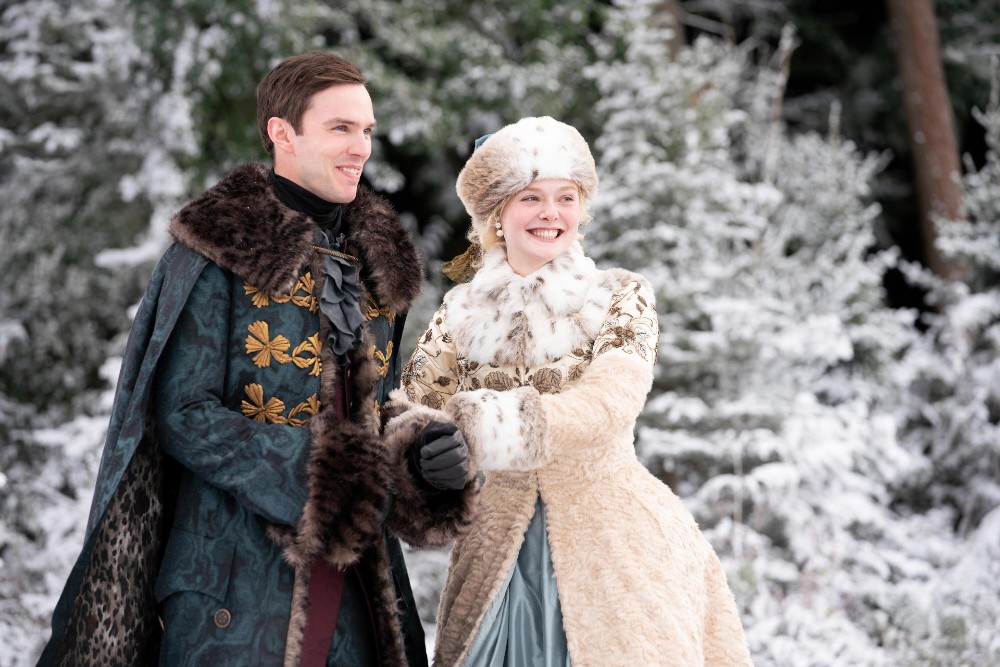
When Catherine the Great strides down the palace halls in Hulu’s The Great, your eyes intrinsically go to her elaborate, ornate 18th century costumes.
They are the work of Sharon Long, who is Emmy-nominated this year for the satirical take on history revolving around a woman seizing the Russian monarchy from her husband, Emperor Peter the Great.
It’s been a wildly comedic ride for three seasons as the young Catherine, played by Elle Fanning, vacillates between love and hate for Nicholas Hoult’s Peter. Meanwhile, the loyalties of the royal court shift according to which one is currently winning the power games they play.
That’s a lot of characters for Long and her team to dress in period costumes for the series.
Below the Line spoke with Long via Zoom from London about creating authentic designs while staying tethered to the 18th century, how the costumes evolve with the storylines and why she enjoys the “extreme” characters the most.
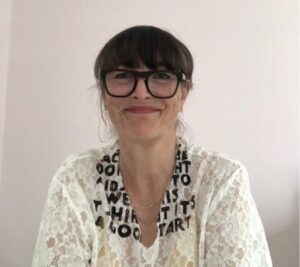
Below the Line: Sharon, you have been nominated for an Emmy again for Outstanding Period Costumes, after winning the trophy in that category last year for The Great. So what does this recognition by your peers mean to you?
Sharon Long: It does mean a lot. I think doing a period satire is quite complicated. I feel that it means that it succeeded. Because it’s quite a tough balance to be period, but to be exciting and to follow quite extraordinary storylines. My crew and I are really close and everybody’s really happy.
BTL: Talk to me about your collaboration with creator Tony McNamara and how you go about the creation of your costumes.
Long: With each of the episodes, we shoot two episodes at the same time, so it’s a block. Before each of the blocks when the script comes out, we have a meeting with Tony and [Producer] Marian Macgowan. And there’s general discussion about the tone and the look in an open kind of way so that we know whether something is a downbeat scene or an upbeat scene. Or whether something needs to be lifted or be dramatic or whether it needs a lot of focus and it’s really important. And then each of the designs that I do goes into Tony to have a look at. And each of the fittings, he gets all the photographs. So there’s a kind of constant dialogue about the look, really.
BTL: How do you conduct your research and then adapt the historical designs from the 1760s?
Long: I do a massive amount of research. I mean, you can research and research and try and find different things that are exciting each time. When you first start, it seems quite daunting to be honest, because it’s all predominantly portraits. They’re people in their best clothes. They’re not people relaxing or eating. So it takes quite a long time to find those kind of images and pull them in so that you get a bit more character into the costumes.
But we can’t use 18th century fabrics because they’re not there. And we’ve got to work on a television timeframe. Every five weeks you’re doing a new two-hour block, so you have to move really quickly. There are all sorts of things to be taken into consideration on where to spend the time. For instance, do you give a certain character a new dress, or do you put the time somewhere else? Excluding Catherine who obviously continually has new dresses and moves forward with everything else. It’s kind of a balancing act.
BTL: Following up on that, how do you balance the elements of visual design and historical accuracy necessary with the practical demands of the job?
Long: One of the things with The Great is that everybody moves how they want to. They’re not moving in a sort of 18th century way. If they want to raise their arms, they’re raising their arms, they’re running around, they’re dancing. All these things mean that we have to make sure that the costumes are very robust that they can actually move, so they’re quite flexible.
But I think always I try to go back to original references. So my mood boards might have contemporary images but never without the parallels of 18th century images so that you don’t go too far away.
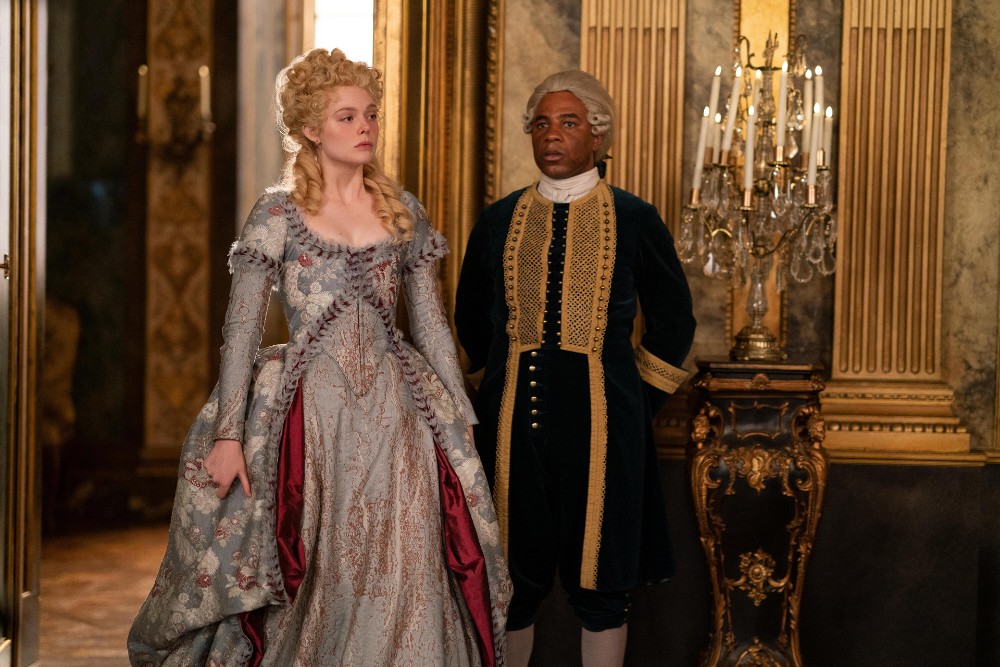
BTL: Describe the evolution of Catherine’s costumes, as she becomes more powerful and eventually the leader of Russia. And then also tell me about your collaboration with Elle Fanning.
Long: Elle’s really great to collaborate with. She’s very, very invested in the project. She’s always read the scripts, got ideas she can visualize, which means that I can send her sketches and we can talk about it. She’s very good with clothes, so she really has vocabulary for costumes. So you don’t have difficulty talking about either fabrics or cut or anything. She’s really knowledgeable and she will always go back to the character. She’s not just interested in looking gorgeous on camera. She’s interested in the whole bigger picture, really, the character and the dresses and her arc.
At the beginning of the season, I have the vaguest glimmer of an idea of what might happen. The development this time in Season 3 was that she starts the series for once not pregnant, because she is pregnant the whole time in Season 2. She’s the mother, she’s a leader and she’s in love. I thought that there was a really good excuse for kind of going bigger and brighter and bolder in her patterns because she’s not frightened of standing out. And there are points where I actually wanted her to be very visible. There’s a scene where she’s speaking to the public and the Russian people have come to her. And I wanted to use that device of royalty where they dress in really strong colors to be seen at a distance.
And we made a fabric that represents parts of Russia and her story and the story of The Great in the print, which obviously you can’t see from a distance, but you see the bright red and the pale blue and it’s really strong.
She reaches a point in the middle of the season where she is wearing animal prints for the first time, which is like Peter. They’re kind of very much echoing each other. And then when she’s in mourning and kind of destroyed, we just let the fabrics get heavier.
There are cracked patterns instead of patterns matching all the time, which we’d always done before. That is a very 18th century thing. If there’s a flower on one side, there’s a flower on the other, and it’s all very symmetrical.
After Peter’s death, it’s not symmetrical. It goes kind of all which ways. We did a bit of Vivian Westwood with the patterns going in different directions.
BTL: Well, then I need to ask you how you felt when you got the script that Peter fell through the ice.
Long: Sad. I knew he was gonna go because by that point, I had been warned of the amount of repeats that he might need because he was going to have an accident. I couldn’t tell my crew because I was supposed to keep it to myself. They found out when they were all reading it and everybody was really upset and people were really upset on set and Nick was really upset and Elle was really upset. It was strange. It was really strange.
BTL: Shifting gears a bit, let’s talk about the undergarments for the women as nearly all the costumes look like they involve very tight corsets that show a lot of cleavage on the likes of Marial, Elizabeth and Georgina [Phoebe Fox, Belinda Bromilow and Charity Wakefield].
Long: [laughs] Yes, that’s true. In the 18th century, nipples weren’t such a no-go kind of area, so it wasn’t so salacious if you slipped out of the top of your dress. Ankles were probably more titillating rather than breasts. So, it’s all very strange. But, yeah, we use corsets. Most of the cast really liked wearing them because they’re really good for posture and they also mean that they feel they’re in the 18th century.
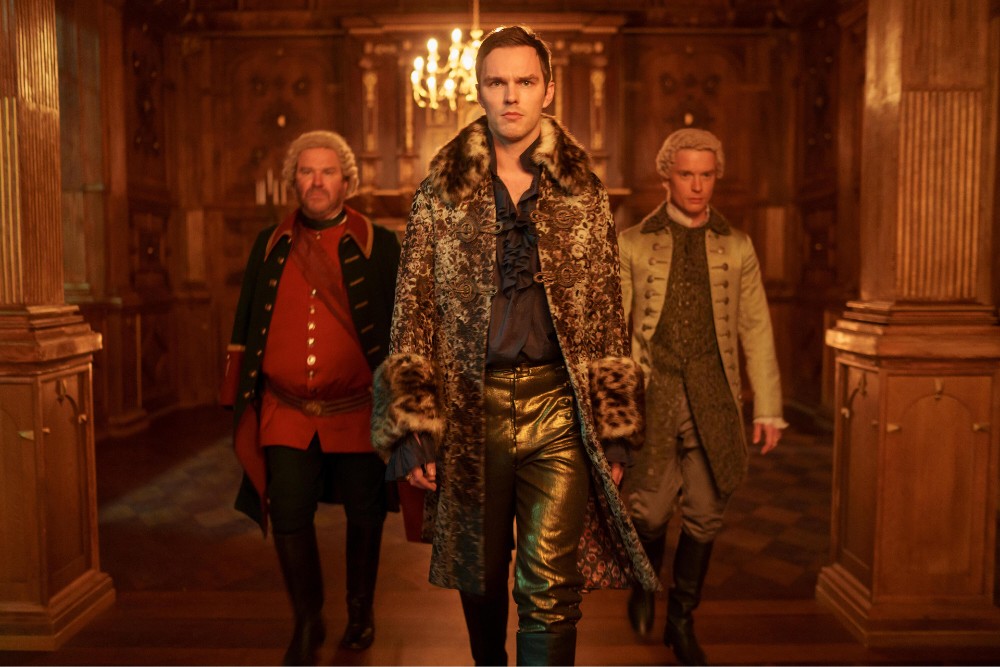
BTL: Archie [Adam Godley] and Velementov [Douglas Hodge] must be pretty simple ones to design for because they pretty much wear the same thing, their respective uniforms as archbishop and general. But talk about Peter’s costumes. He is often seen in heavy fur coats and it seems like a signature chunky necklace.
Long: His whole character developed in Season 1, which I didn’t do. So he was sort of decadent and a bit of like a rock star really in the palace. He’s got a sort of a complete presence. Emma Fryer who did Season 1 used quite a bit of animal print and really I just took that and ran with it. And so he never doesn’t really display some animal print of all different kinds, really exotic. And Nick himself is very comfortable wearing feminine fabrics. We kind of mixed things up so that it didn’t matter if he had a frilly shirt or a lace shirt or glitter or gold he still looked fantastically handsome and masculine.
BTL: With King Hugo and Queen Agnes [Freddie Fox and Grace Molony], how do you differentiate the costumes of this Swedish royal couple from their Russian counterparts?
Long: The idea was that they were supposed to be icy. At some point, it was suggested that they were kind of like the mid-century modern version of the Russian royals. They’re all kind of a bit clean and crisp and “Scandy” and everything. They start to get a bit warmer because they’re in the Russian court, so as the ten episodes go along, the colors are getting less silvery and just going into one of more blues. I think she’s got some pink in there and some slight floral prints. And Agnes stopped having the kind of white wig, so sometimes she’s got her own hair. I like those two. I think they’re really funny.
BTL: Oh, they are. But this is also I believe the first season you’ve had to dress a baby, the emperor-to-be, Paul.
Long: That was quite funny because Paul is actually played by twin girls [laughs]. We had to do the two girls and the dummy baby. So each time there’s one, there’s three. The babies grew, so we didn’t do that many costumes for them, but we did have to keep extending the costumes. We did these intarsia hand-knitted suits, some with little ducks and rabbits all over and some with antlers and everything.
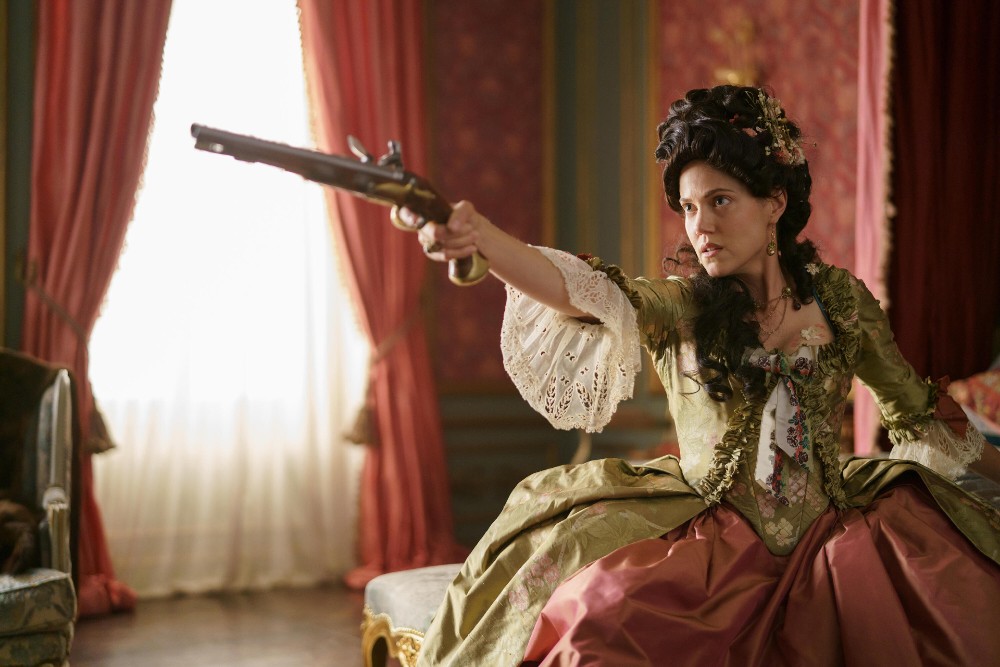
BTL: So which of the characters do you enjoy designing for the most and which ones are the most challenging?
Long: I would say that I enjoy Catherine and Maxim [Henry Meredith] and Elizabeth because they’re all kind of extreme. I think the most challenging characters are the men, unless they’re flamboyant, like Voltaire [Dustin Demri-Burns]. To do Voltaire isn’t difficult, but it’s much more challenging to do Grigor [Gwilym Lee] and the sort of men that need to look handsome and have character. It’s harder to find their fabrics as well. It’s quite a struggle to get those kind of fabrics that aren’t too feminine and remain kind of masculine, but catch the light yet don’t go too dark.
BTL: You have worked on some incredible films, including Gangs of New York, Guardians of the Galaxy, Phantom of the Opera and The Social Network. So what learnings did you take from those experiences and possibly put into your work on The Great?
Long: I worked for a long time as an assistant designer and a supervisor with Sandy Powell and Alexandra Byrne. Because they’re such good designers, you are learning all the time. I suppose the great thing about both of them was they were doing those incredible films at the time. There’s always a different set of challenges. Guardians of the Galaxy was the first time I’d worked on a superhero thing, so you’re kind of learning along with your designing really, which is great.
BTL: With the current labor impasse and as a creative person in the industry, what are some of your biggest concerns right now?
Long: It is affecting us here [in the U.K.] because obviously there’s so many American productions or productions with American stars or American writers. It’s very quiet now and I get concerned about the support industries too, the costume houses and the makers. And, because if they’re not supported, then what do we do when it picks up? If they decide to leave the industry, where does that leave us when things do pick up and we need to go back to work? I’m sure you’re all worried. Everybody’s worried, aren’t they?
All three seasons of The Great are streaming on Hulu.





